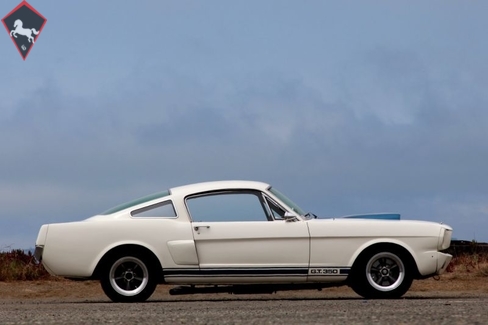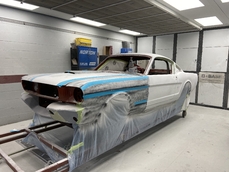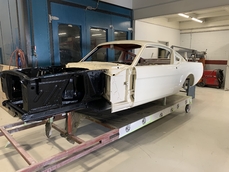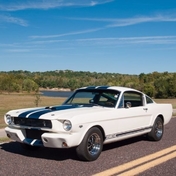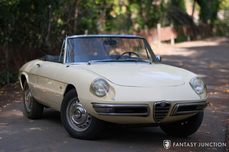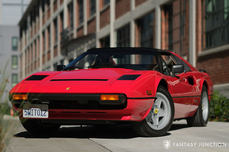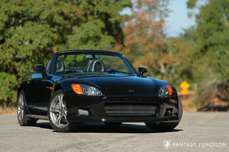Shelby GT 350 289 c.i. V-8 1966
General description :
This car is currently not at Fantasy Junction but can be viewed by appointment1966 Shelby American GT350
s/n SFM 6S342
White with Black Interior
Nothing says American performance like Carroll Shelby. With his legendary Cobra, LeMans winning bravado, and Texas homespun charm, Ford knew they could count on ol’ Shel to deliver a genuinely high performance race ready variant of the already successful Mustang. The production GT350 was fast, loud and exhilarating to drive, a uniquely brawny American GT that was a match for almost any other machine on the road. But the production GT350 was a carefully planned compromise, a streetable allowance toward the car Shelby intended to race – the GT350R, the “R” signifying its racing specification.
The production GT350 suspension, steering and brakes were already outfitted for SCCA competition, but the R-model’s K-code 289 powerplant needed work. R-model engines were built to order, using blueprinting, heads ported and polished by Valley Head Service, Tri-Y headers by Cyclone, a center-pivot-float Holley 715 CFM carburetor on a Cobra intake and flow-through side-exit exhaust. Outputs ranged from 325 to 360 horsepower on the Shelby dynamometer. Differential and engine oil coolers were added, the latter necessitating the distinctive fiberglass front valence that distinguished the R-model. Plexiglas replaced the R-model’s side and back windows, the fenders were flared to accommodate wider Goodyear racing tires; a four-point roll bar was welded in and a quick-fill 37-gallon fuel tank was installed in the trunk. The GT350R was the full realization of Shelby’s plan for a racing Mustang, and it immediately dominated SCCA B-Production racing.
The GT350R instantly became the template for racers hoping to emulate Shelby’s winning formula but unable to buy one of the 34 built by Shelby American. In 1966 Shelby knocked some of the rough edges off the production GT350, requiring more work to convert the street version to so-called “R spec” configuration. Still, independent competition GT350s proliferated, a few even springing up across the ocean in Britain and Europe. One of the most interesting of these is our featured offering, a 1966 GT350 owned and raced by Swiss ace driver Herbert Müller from 1966 through the early 1970s. This GT-350 started life as a European export model shipped to Ford Advanced Vehicles in Slough, England. Once in the UK it was modified with R-Model type racing equipment including a roll bar, oil cooler, 37-gallon fuel tank, fiberglass front valence, and American Racing Torque Thrust “D” alloy wheels. The icing on the cake however was the amazing engine; aWeber-inducted GT40 engine built by Holman-Moody.
The cherubic, friendly Müller was the kind of fearless racer to whom the GT350 had instant appeal. Müller had become one of the most experienced and accomplished drivers in the world of sports and prototype racing by the time of his tragic death at the 1981 Nurburgring. He began his career in 1959 racing motorcycles and advancing to European hill climbs. Driving a series of Porsche GT racers, he became especially successful in the FIA European Hill climb Championship, winning the GT Championship in 1963. While his speed and grace behind the wheel was opening doors into international GT and endurance racing with Porsche, Ferrari and Ford, Müller also kept his hand in hill climbing, often taking his son to weekend events in his 1966 GT350.
After his passing, Müller’s personal car collection sat dormant until 1985, when Ron Randolph, a civil engineer with the Army Corps of Engineers in Frankfurt and an accomplished restorer of vintage sports cars, learned of the Müller GT350 through exotic car dealer Auto Exclusive of Zurich, Switzerland, whom Müller’s son had asked to broker its sale. First Randolph had to convince the young man that he would properly care for the car. Randolph later recounted the occasion: “When I told him I planned to restore it completely, take good care of it and race it in historic events in Europe, he thought it over, then reluctantly decided to sell it. He had an attachment to the car because his father took him to races in it, and then raced it, and then they would return home in it. Those were the days when you could drive your racecar to the track. So the car was part of the family. But Müller’s son obviously liked the idea of the car returning to racing instead of sitting around in the garage.”
After years of storage the car remained solid but needed to be completely rebuilt, a task that took Randolph and his friend Rich Bard over 600 hours to complete. They stripped it down to bare metal, repainting it in the original Wimbledon White with Guards Blue stripes before rebuilding the entire car. Randolph: “We worked in the (USAFB) Rheine-Main Auto Craft Shop right from the beginning, where we disassembled most of the car, went down to bare metal on the underbody, stripped off all the old paint – everything. I rebuilt the engine, reworked the body where necessary, along with the suspension, brakes and everything else. We also sanded the body down for painting; it’s a complete restoration job.”
Randolph completed the car in time for the August 1986 Nurburgring Historic race. Electrical gremlins kept it from lapping the storied German circuit on that first outing, but Randolph subsequently raced the car regularly before displaying it at the Nurburgring Race Car Museum and then lending it to Peter Kaus’ famous Rosso Bianco Collection in Aschaffenburg, Germany, in 1988. It remained there for 18 years before Randolph once again assumed its care and maintenance.
Shelby serial number SFM6S342, the Müller GT350 remains configured as it was when delivered by Ford Advanced Vehicles, retaining the Holman-Moody-built GT40 engine. It is best described as having an honest, top-tier driver presentation inside and out, and is in outstanding mechanical order. Serial number SFM6S342 is officially listed as an Independent GT350 Racer in the Shelby Registry and is offered with extensive supporting documentation, including contemporary news articles, a copy of the invoice from Shelby American to Ford Advanced Vehicles and a copy of the letter from Auto Exclusive to Ron Randolph confirming the Müller estate’s interest in selling the car.
Recent mechanical work has been performed with all parts sources from Cobra Automotive, including new fuel lines with 4 banjos replaced, driver’s seat replaced (former one retained and included with the spares), front brake calipers rebuilt with new wheel cylinders using Porterfield rear shoes and front pads (former pads in spares), engine mounts replaced, new Tru-Trac posi-differential with new ring and pinion, axle bearings replaced with new seals, and new Optima battery. A nut and bolt “Race Prep” has been done on the car and all systems are operating as expected.
Today SFM6S342 remains as one of the most thoughtfully prepared Shelby Mustangs outfitted with R type features and documented period racing history. Cosmetic condition is very nice overall with suitable racing patina echoing use and preservation consistent with dedicated enthusiast ownership. Paint remains very nice overall with some chips due to road use and good chrome overall. Care has been given to retain proper engine fittings and finishes without compromising use. Interior is in excellent condition, featuring Carroll Shelby glovebox signature, fire extinguisher, and rear seat delete panels. Undercarriage is in very nice condition overall with most finishes as originally specified from the factory, allowing some concessions for modern safety and improved use.
SFM6S342 is offered with a massive documentation binder outlining Müller’s racing exploits (mainly in Porsches), photos of the body restoration process showing excellent structural integrity, documentation from Auto Exclusive in Switzerland regarding the sale in 1985 to Ron Randolph, and newspaper articles outlining the car’s history with Randolph and before. It is also offered with a second set of wheels, and an extra engine block and single head, among other minor yet helpful spares.
With its unique racing history, European and American provenance, and highly desirable Holman-Moody built GT40 engine, this Independent Competition GT350 remains a refined and capable example of Carroll Shelby’s vision for building a competitive American performance car. It is eligible for many prestigious events around the globe, and with its interesting early competition history, will surely enjoy heightened acceptability over standard converted street GT350s.Pricing flexibility exists for offers with a close prior to or during December of 2016.
http://fantasyjunction.com/cars/1573-Shelby-GT350-289%20c.i.%20V-8
1966 Shelby GT 350 289 c.i. V-8 is listed sold on ClassicDigest in Emeryville by Fantasy Junction for $265000.
Car Facts
Car type : Car Make : Shelby Model : GT 350 Model Version : 289 c.i. V-8 Engine size : 0.0 Model Year : 1966 Location : Emeryville
Sold
Seller Information
Sold
People who viewed this Shelby GT 350 also viewed similar Shelby listed at ClassicDigest
Other cars listed for sale by this dealer
About Shelby
Carroll Shelby, a legendary figure in the automotive world, had a remarkable journey from being a successful race car driver to becoming a renowned sports car manufacturer in the United States. His story is filled with achievements, innovations, and iconic cars that left an indelible mark on the industry.Early Years and Racing Career:
Carroll Shelby was born in 1923 in Texas. He initially pursued a career as a pilot during World War II but found his true passion in racing after the war. Shelby became a successful race car driver in the 1950s, competing in various events including Formula One, endurance racing, and the famous 24 Hours of Le Mans.
Shelby Cobras - Iconic Sports Cars:
Carroll Shelby's pivotal moment as a manufacturer came with the creation of the Shelby Cobra, an iconic American sports car. The Cobra was born from the fusion of a British AC Ace chassis and a Ford V8 engine, creating a lightweight, high-performance car that dominated tracks and streets alike. Key models include:
Shelby Cobra 260 (1962): The initial version with a 260 cubic inch (4.2L) V8 engine.
Shelby Cobra 289 (1963-1965): Later iterations with a 289 cubic inch (4.7L) V8 engine, including the competition-spec Cobras known for their racing prowess.
Shelby Cobra 427 (1965-1967): The most powerful iteration with a 427 cubic inch (7.0L) V8 engine, known for its raw power and performance.
Ford Partnership - Shelby Mustangs:
Shelby's partnership with Ford led to the creation of legendary Shelby Mustangs. The most notable model is:
Shelby GT350 (1965-1969): Based on the Ford Mustang, the GT350 was modified by Shelby American, featuring enhanced performance, handling, and distinct styling.
Other Notable Models and Achievements:
Beyond the Cobras and Mustangs, Shelby had several other significant contributions:
Shelby Daytona Coupe: Created to win against Ferrari in international GT racing, this car became the first American car to win the FIA GT World Championship in 1965.
Shelby Series 1: Introduced in the late 1990s, this was Shelby's modern take on a high-performance sports car.
Ford GT40 plays a pivotal role in Carroll Shelby's narrative, especially in his connection to Ford and his significant contribution to the car's success.
The Ford GT40 Development:
Ford's Challenge:
In the early 1960s, Henry Ford II sought to acquire Ferrari, but negotiations fell apart. This spurred Ford's determination to beat Ferrari at the prestigious 24 Hours of Le Mans endurance race, which Ferrari had dominated for several years.
Collaboration with Shelby:
Ford turned to Carroll Shelby, recognizing his racing expertise and track record. Shelby was tasked with leading the GT40 project and turning it into a competitive race car capable of challenging Ferrari's supremacy.
Development and Triumph:
Under Shelby's guidance, the Ford GT40 underwent rigorous development to address initial design flaws and performance issues. Several iterations were produced:
Early Attempts: The initial versions of the GT40 faced reliability and handling issues, leading to disappointing results at Le Mans in 1964.
GT40 Mark II: Shelby's team made crucial improvements. The Mark II, equipped with a powerful V8 engine, improved aerodynamics, and refined engineering, became highly competitive.
Le Mans Victory:
In 1966, the Ford GT40 Mark II achieved a historic victory at the 24 Hours of Le Mans, with Shelby-coached driver Ken Miles leading the race. This marked the first win for an American manufacturer at Le Mans, breaking Ferrari's dominance.
Continued Success:
The GT40 continued to dominate, winning Le Mans for the following three years (1966-1969), securing its place in racing history and solidifying Ford's reputation as a force in international motorsport.
Shelby's Contribution to the GT40 Success:
While Carroll Shelby wasn't directly involved in designing the GT40, his expertise in racing and his ability to assemble and lead a team of talented engineers, mechanics, and drivers were instrumental in refining the car's performance. His influence helped address technical issues, refine the car's handling, and strategize race tactics, contributing significantly to the GT40's success on the track.
Legacy and Impact:
The Ford GT40's victories at Le Mans under Shelby's guidance remain one of the most iconic achievements in motorsport history. The car's success solidified Shelby's reputation as an automotive visionary and further strengthened his partnership with Ford.
Carroll Shelby's involvement in the GT40 project showcased his ability to transform a struggling project into a championship-winning machine, adding another remarkable chapter to his illustrious career in the automotive world.
